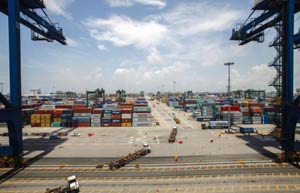 |
|
People cross a bridge at Pudong financial district in Shanghai August 11, 2014. [Photo/Agencies] |
The amount of money flowing into China's economy slowed to the lowest level in nearly six years in July, adding to fears that a sustained recovery may be at risk in the second half of the year despite government efforts to shore up growth.
Both the central bank and economists had expected some payback in July after unexpectedly strong financing data in June, but new loans and money supply growth were far below economists' expectations.
China's total social financing (TSF) aggregate, a broad measure of liquidity in the economy, fell to 273.1 billion yuan ($44.34 billion) in July, about one seventh of that in June and the lowest monthly reading since October 2008 in the depths of the global financial crisis.
The People's Bank of China took the unusual step of issuing a statement immediately after the data, reassuring markets that credit and financing growth was still reasonable and that it had not changed its monetary policy.
Still, it conceded the slowing economy, and in particular the cooling property market, were dampening loan demand and highlighted the risks of pumping too much money into a softening economy too quickly, citing the growing number of bad loans.
Non-performing loans have now risen for 11 straight quarters, the central bank's statement said.
Chinese banks made 385.2 billion yuan ($62.53 billion) worth of new yuan loans in July, down sharply from 1.08 trillion yuan in June and well below expectations of 727.5 billion yuan, central bank data showed on Wednesday.
The People's Bank of China said in its second quarter policy report earlier this month that it will maintain reasonable growth in credit and social financing and fine-tune its monetary policy in a timely way.
But it also sounded a cautious note by saying that bank credit is already too large and it needs to be mindful of inflationary risks.
That echoed analysts' concerns about how much of June's loan surge was going into real economic activity and how much may be going into speculative activities.
Broad M2 money supply rose 13.5 percent last month from a year earlier, the People's Bank of China said in a statement on its website, www.pbc.gov.cn, lower than the forecast 14.4 percent rise.
Outstanding yuan loans grew 13.4 percent from a year earlier versus forecasts for growth of 14.0 percent.
Beijing stepped up efforts to re-energize China's economy in June, pumping more money into the system and pressing banks to extend more loans. Those steps and other stimulus measures earlier in the year appear to have offset the drag from a weakening property sector and sluggish exports, but analysts say more support may be needed to sustain a recovery.
China's main stock index, the Shanghai Composite Index, reversed early gains and fell 0.8 percent after the credit data was released.
 |
 |
| China's local GDP data points to recovery, rebalancing | 10 Chinese cities that lifted property curbs in July |
